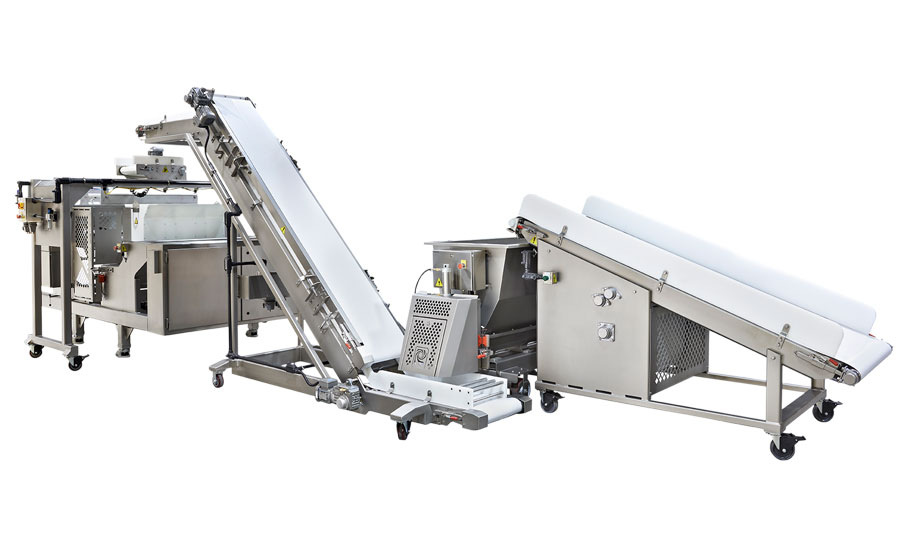The snack and bakery product tastes of modern consumers are always evolving. While the public might be clamoring for gluten-free items now, for example, they might be more inclined to choose gluten-full items down the road.
As consumers’ products change, bakery technology like dough handling equipment typically is expected to change along with it. Snack Food & Wholesale Bakery recently touched base with technology providers to check in on what’s happening, and what’s coming, with dough handling.
Dough handling trends
Changes in demand, new product innovations, market conditions, and myriad other factors stand to impact dough handling equipment. According to Jamie Bobyk, marketing consultant, Apex Motion Control, automated technology is important and will only become more vital in the future.
“Aside from advances in traditional dough handling equipment—like rounders, molders, mixers, and dough conditioning that allow for optimum elasticity and extensibility, and the ability to handle gluten free, keto, and artisan style doughs—cobots in particular are becoming a popular choice for catching pre-risen dough balls from conveyors onto trays, as well as moving fully loaded oven ready pans to the conveyor on the way to the oven,” says Jamie Bobyk, marketing consultant, Apex Motion Control. “Cobots have proven to be more than capable workers that filled the gaps left by labor shortages.”
Nico Roesler, North American pretzel and snack equipment sales manager, Reading Bakery Systems, says automation is increasingly of interest to bakery producers when considering equipment needs.
“Operators are looking for automated solutions that provide flexibility and sanitary design,” he says. “We’re seeing increased interest in automation because it reduces the required labor in the dough handling part of the process. These jobs can be difficult for operators as they are usually dealing with large, heavy amounts of dough. Removing this type of work eliminates risk not only for product but also for people.”
Ken Hagedorn, vice president for the bakery sector, Handtmann, offers that reliability (already a perennial concern to producers) is becoming a more significant focus.
“The production pressures of the last few years have made reliability even more important. Our customers have been addressing the added risks with more focus on the timeliness, quality, and their control over maintenance,” he advises, adding that preventative maintenance programs can help producers keep a handle on their operation, and keep their equipment running smoothly.
Product trend impact
Bobyk points out that while new dough handling equipment is expected to take care of products that fit into a current trend (for example, gluten-free and keto items), it also must be up to handling products in line with the next trend.
“Generally speaking, new equipment is not designed for trends and fads,” he advises. “Existing equipment can be customized slightly to handle the small nuances in these non-traditional products.”
Roesler says that the particular product trends can create special demands upon a producer’s equipment, necessitating different parts and tech.
“Trending gluten-free doughs require some special considerations when thinking about dough handling,” Roesler says. “First, in mixing, the doughs may require different paddle or mixing element configurations to create a homogenous dough; this can be accomplished through batch or continuous mixing. In batch mixing, a dough may have to rest for long periods before it gets processed and baked; This can create inconsistent finished product and can negatively impact sheeting and processing.”
“Continuous mixing, however, creates dough that is first in first out and the time it takes to be mixed, processed, and baked never changes,” Roesler continues. “This means the dough does not have a chance to dry out more than it should while it sits in a hopper. Instead, it can be continuously fed into an extruder or sheeting system to create consistent results from start to finish.”
Another trend impacting equipment is the need for large numbers of high-quality baked goods. “The continuing move to industrial-volume, artisan-quality products with premium inclusions puts big demands on equipment for gentle handling,” notes Hagedorn. “The ability of equipment maintain inclusion integrity is very important, not only to get the highest value out of costly ingredients, but also because of the importance of visual impressions with consumers.”

And, Bobyk adds, equipment manufacturers, much like producers, “must continually keep their finger on the pulse and often times, react to sudden consumer demands.”
Operational data
Roesler says collecting and analyzing operational data can help producers achieve and maintain consistent product and improve quality, particularly in continuous mixing applications.
“Gathering of data is a mainstay of continuous mixing,” he remarks. “While collected data can be used to ensure quality, in the case of continuous mixing the data can be used to make process intervention and corrections without the involvement of the operator.”
Hagedorn says in order for a bakery operation to succeed, dough-handling equipment (and other technology in a production environment) need to adapt rapidly, which can be made possible through integration of tech that facilitates advanced monitoring, control, and secure communication.
“At Handtmann, this adaptability is not a big leap but has been designed into our development processes for decades; our Handtmann R&D, engineering, and manufacturing teams continuously design and implement a very wide range of adaptable digital solutions to better monitor parameters and control processes as standard equipment in our technologies,” he notes.
Hagedorn adds that keeping tabs on such data can help current equipment and the producers employing it “meet tomorrow’s challenges with regular software updates and system innovations.
Flexibility
Producers increasingly demand their equipment be able to handle different types of product, and adjust to changes yet to come. Roesler says equipment producers like Reading Bakery Systems are ready to deliver.
“RBS dough handling equipment is versatile and can handle any type of dough,” he comments. “Laytime conveyors allow dough to sit and ferment if required, or we can create automated dough trough systems for doughs that require many hours of fermentation. The mixer discharge conveyors can be used for multiple dough types and can transport dough to any downstream equipment.”
Bobyk remarks that the public’s hunger for new, different bakery items drives the need for innovative bakery technologies.
“As long as consumer demand is around, equipment manufacturers will keep developing new technologies to accommodate those needs,” he says.
Labor and automation
Labor shortages were a pressing issue before the pandemic; COVID-19 has made such concerns even more of a headache. According to Bobyk, workforce woes inevitably will continue, necessitating increased reliance on automation.
“Cobots will be the future production workers; the labor shortages will assure this,” Bobyk says. “Whether it be working alongside human workers or running the entire production line in a semi-autonomous fashion, seeing cobots through production facilities will become the norm.”
Bobyk concurs that labor challenges will worsen, adding that producers have to consider equipment and processes that will help them down the road.
“Ingredients costs will always fluctuate, real estate and utility costs will always fluctuate, and you can generally battle these by adjusting your prices, but if you do not have the workforce to help make your products, it will be hard to keep the lights on.”





